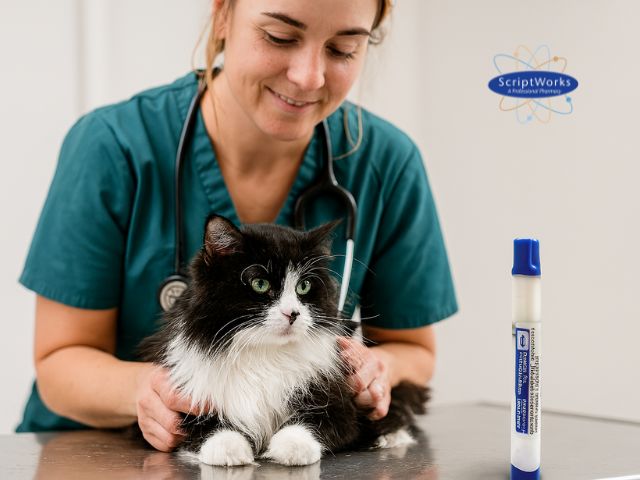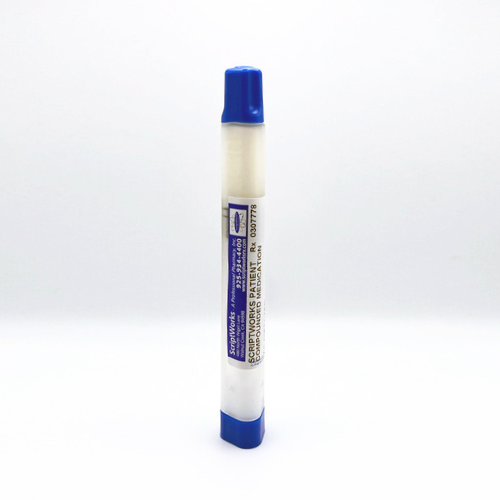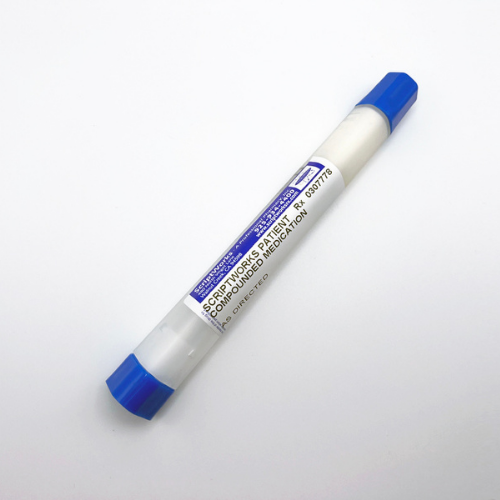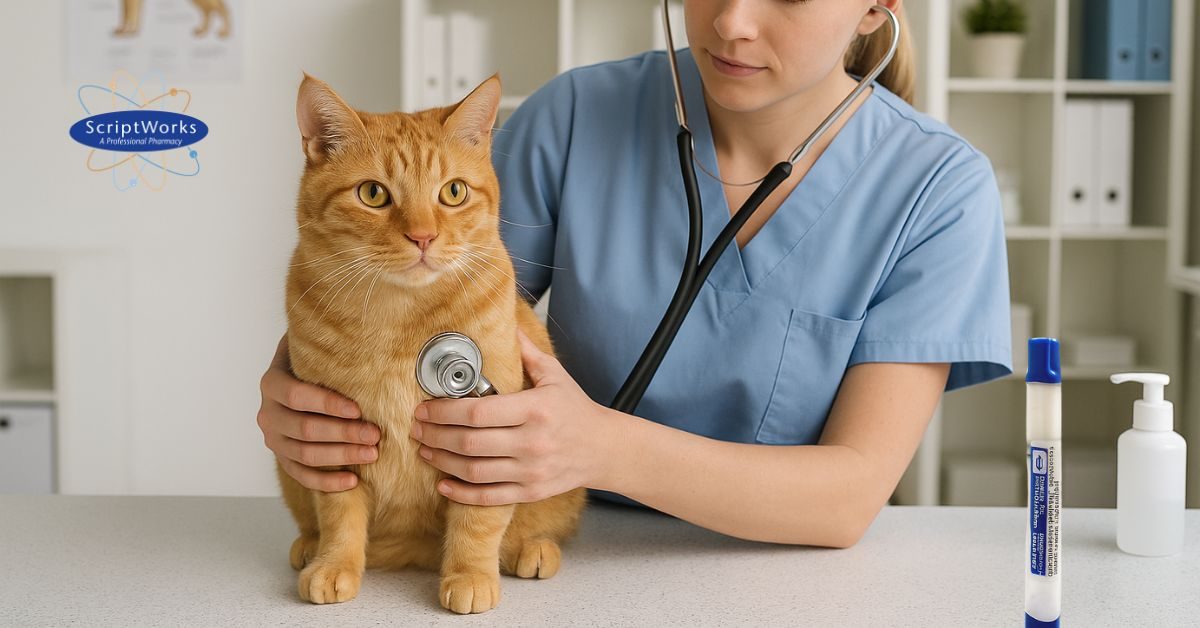
Author: Bob Brensel | President, Pharmacist | ScriptWorks
Bob Brensel, RPh, earned his Pharmacy Degree at University of the Pacific in Stockton, California in 1980. Former California Pharmacists Association’s Award Winner for Recognition of Outstanding Achievement in Compounding Pharmacy. Read More →
Picture This…
A sweet senior calico named Luna prances into a California veterinary clinic. She’s lost two pounds since last visit, paces anxiously, and her owners are anxious too. A beloved member of their family — curled up beside a child at bedtime — Luna’s weight loss and restlessness have thrown the household into quiet worry. This is what hyperthyroidism in cats looks like — an endocrine challenge that ripples through the entire family.
Why California Cats — and Their Families — Need Smart Management
Hyperthyroidism is the most common endocrine disease in senior cats. It causes excess production of thyroid hormones, which may turbo‑charge metabolism.
Classic red flags include:
- Weight loss despite a ravenous appetite
- Increased thirst, frequent urination
- Restlessness or hyperactivity
- Vomiting or diarrhea
- Cardiac issues like elevated heart rate or hypertension
Cat owners cherish their pets as family. So they worry when health declines. For veterinarians, this anxiety adds pressure: not only is medical care needed but also emotional support for families who fear for their furry loved one.
Why Methimazole for Hyperthyroidism in Cats?
Methimazole is an antithyroid medication widely used in veterinary medicine to manage hyperthyroidism in cats.
Hyperthyroidism in cats is primarily due to excessive production of thyroxine (T4) and triiodothyronine (T3). Methimazole’s mechanism of action centers on inhibiting thyroid hormone synthesis. Specifically targeting and inhibiting thyroid peroxidase, a key enzyme in thyroid hormone biosynthesis.

Methimazole is an antithyroid medication widely used in veterinary medicine to manage hyperthyroidism in cats.
Hyperthyroidism in cats is primarily due to excessive production of thyroxine (T4) and triiodothyronine (T3). Methimazole’s mechanism of action centers on inhibiting thyroid hormone synthesis. Specifically targeting and inhibiting thyroid peroxidase, a key enzyme in thyroid hormone biosynthesis.

This inhibition reduces the formation of both T3 and T4 hormones, gradually normalizing thyroid function over time. , helping restore hormonal balance in hyperthyroid cats.
Common Pain Points California Vets Face
Let’s dive into real-world scenarios California veterinarians face in treating hyperthyroid cats:
- Medication compliance headaches
- The finicky eater: Fluffy, a long-haired Maine Coon, vehemently refuses pills. Every oral dose becomes a wrestling match — scratching, hissing, cat-carrier battles.
- The forgetful family: Busy working professionals struggle to stick to a twice-daily pill schedule. Challenges are time-consuming, and missed doses lead to unstable thyroid values and reactive vet visits.
- Stress-sensitive cats
Many hyperthyroid cats are physically and emotionally fragile. - Side‑effect sensitivity
- Methimazole oral tablets may cause mild GI upset, inappetence, or lethargy. For sensitive cats like older Persian breeds or those with renal issues, finding a well‑tolerated option can feel like walking a tightrope.
Why Methimazole Transdermal Lipoderm® May Be a Game-Changer
Enter transdermal Lipoderm cream or gel — a compounded methimazole formulation applied to the ear flap. Preferred by California veterinarians and pet parents over oral pills or tablets.
Here’s why it matters for California vets — and families:
- Easy administration
No pills required. Just a small dab on the ear, once or twice daily. For cats like Fluffy, this means less stress — no pill pouches, food hiding tricks, or forced feeding. - Reduced GI upset
Since medication bypasses the gut, cats with sensitive stomachs may tolerate it better. GI issues drop, reducing vet calls and promoting happier patients. - History of Safety
Methimazole in Transdermal Lipoderm® has been available for cats for almost 20 years now with an excellent safety record in cats.

- Easy administration
No pills required. Just a small dab on the ear, once or twice daily. For cats like Fluffy, this means less stress—no pill pouches, food hiding tricks, or forced feeding. - Reduced GI upset
Since medication bypasses the gut, cats with sensitive stomachs tolerate it better. GI issues drop—reducing vet calls and happier patients. - History of Safety
Methimazole in Transdermal Lipoderm® has been available for cats for almost 20 years now with an excellent safety record in cats.

Transdermal formulations provide a viable route for medication administration, especially in cats with poor oral tolerance, while maintaining the drug’s mechanism of action and therapeutic efficacy. Continued monitoring and individualized dosing remain essential to achieving and maintaining euthyroid status.
WATCH VIDEO
How to use a Topi-CLICK® Micro Pen for administering pet medications.

Collaborating with ScriptWorks: Better Experiences for Animals and Their Families
California cats need personalized formulations; standard pharmacy meds don’t always fit the bill. That’s where ScriptWorks steps in — partnering with veterinarians statewide.
See examples of how we can work together with veterinarians to optimize cats’ treatment strategies. For illustration/demonstrative purposes only.
Example 1: The Allergic Maine Coon
Dr. Hernandez in Fresno faces Fluffy’s brutal fight for oral pills. Fluffy’s GI tract rebelled; appetite nosedived. Through ScriptWorks, she transitioned him to methimazole Lipoderm®. The result: a calm, stress-free therapy at home. Weekly ear rubs instead of pill battles — and a purring Fluffy, back to normal weight — all the way to Madera.
Example 2: The Busy Silicon Valley Startup Family
Dr. Patel in Palo Alto treated Mr. Mittens, a senior Siamese beloved by busy CEO parents. Mr. Mittens makes it difficult and time-consuming during medicine time, where his parents need a quick and easy option. ScriptWorks crafted a clear dosing plan for Lipoderm gel alternative — application instructions to the point. Now it’s incorporated into their morning coffee routine, making it easy to remember.
Practical Tips for California Vets
- Talk through pain points
Ask pet owners about their household dynamics — who administers meds, is pill hiding a challenge, or is the patient stressed at home? This info helps guide decision-making. - Plan structured follow‑up
Offer follow-up calls 1–2 weeks after dispensing methimazole Lipoderm®. Monitor thyroid levels at 2-week intervals for the first month. Early dose tweaks reduce false starts and complications.
Touching the Heart of the Matter
At the end of the day, it’s about love. Cats are family — little spirits who share mornings, evenings, secrets, and quiet moments on the couch. When Luna struggles, the whole family feels it: whispered goodnights, worried silence, teary smiles. When Mittens can’t balance physiologically, parents miss their gentle bedtime kisses.
By offering smoother, gentler treatment experiences — like transdermal methimazole Lipoderm® — veterinarians do more than manage disease. They restore peace, remove daily stress, and preserve routines. They let families keep their continuity — busy workweeks, school mornings, and weekend cuddles — without interruption.
Key Potential Benefits: At a Glance
| Potential Benefit | Who It May Help | How It Supports |
|---|---|---|
| Stress-free dosing | Pill-averse or fractious cats | No wrestling, no hiding meds |
| Improved GI tolerance | Cats with nausea or appetite issues | Fewer side effects |
| Steady dosing | Cats with variable oral absorption | More stable lab results |
| Family-friendly | Busy or multi-person households | Easy tracking, consistent care |
| Supportive partnership | Vets needing flexibility and innovative options | ScriptWorks provides meds, dosing guidance, follow-up |
Working with ScriptWorks: What’s the Experience?
- Easy prescribing
Veterinarians submit a simple script specifying dose and frequency. ScriptWorks crafts the transdermal methimazole Lipoderm® formulation in-house, tailored precisely. Veterinary portal available for easy medication management. - Ongoing consult support
If dosage adjustments are needed, ScriptWorks’s pharmacy team is ready to consult with both the veterinarian and the pet owner. - Delivery to clinic or home
California-wide shipping means even remote clinics in rural Imperial County or Big Bear get fast delivery. No gaps in supply, no waiting weeks.
Does your pet need medicine now?
SCRIPTWORKS DELIVERS.
Animals can't wait around weeks for medications.
Get prescriptions when they need them.

Weekday Local Deliveries
Walnut Creek, Concord, Martinez, San Ramon, Danville, Alamo, Lafayette and Orinda.
USPS 1st Priority Mail Overnight Mail Delivery
California (state-wide)
Bringing It All Together: A Happier Future for Cats and Families
Hyperthyroidism in cats can be manageable — but only when medicine fits the lifestyle and specific needs of each cat. For California veterinarians, that means understanding each cat’s sensitivities, quirks, and each household’s daily flow. By offering methimazole transdermal Lipoderm® — and partnering with ScriptWorks — vets gain:
- A compassionate option for medication-challenged felines,
- Reassurance for families that care fits into their real lives,
- A steady hand on thyroid control with fewer side effects,
- Access to a supportive compounding partner who cares about med accuracy, compliance, and follow-up.
California Veterinarians: Get Started Now
Our California cats — from suburbs to coastal condos — deserve pain‑free, loving care. Their families deserve confidence and ease in administering medicine, not stress. By embracing custom compounded medicine, veterinarians become champions for both cat and caretaker, nurturing health and harmony.
If you’re a California veterinarian looking to offer methimazole transdermal Lipoderm®, ScriptWorks is ready to start a long-lasting professional relationship to enhance your offerings.
We’re Northern California’s veterinary compounding pharmacy, shipping statewide
Walnut Creek
Concord
Martinez
San Francisco
Oakland
Berkeley
Danville
Lafayette
Alamo
Marin County
Mill Valley
Santa Rosa
San Rafael
Tiburon
Corte Madera
Sausalito
Novato
Larkspur
San Anselmo
Fairfax
Ross
Kentfield
Let’s shape more stories like Luna’s — where aging cats find renewed well‑being, families feel relief, and vet clinics stay true to their calling: compassionate care, one whisker‑soft purr at a time. Together, we can help them thrive.
Lipoderm® is a registered trademark of PCCA.
Resources
Boretti, F. S., Sieber-Ruckstuhl, N. S., Schäfer, S., Gerber, B., Baumgartner, C., Riond, B., … & Reusch, C. E. (2014). Transdermal application of methimazole in hyperthyroid cats: a long-term follow-up study. Journal of feline medicine and surgery, 16(6), 453–459. Link
Hicks, E., & Murphy, P. Z. (2019). Transdermal Methimazole for Feline Hyperthyroidism. Open Acc J of Toxicol, 4(1), 555–630. Link
Hill, K. E., Gieseg, M. A., Bridges, J., & Chambers, J. P. (2011). The efficacy and safety of a novel lipophilic formulation of methimazole for once daily transdermal treatment of cats with hyperthyroidism. ResearchGate. Link
Hill, K. E., Gieseg, M. A., Kingsbury, D., Lopez-Villalobos, N., Bridges, J., & Chambers, P. (2014). Pharmacokinetics of methimazole in a novel lipophilic formulation administered transdermally to healthy cats. New Zealand Veterinary Journal. Link
Hill, K. E., Mills, P. C., Jones, B. R., Bolwell, C. F., Aberdein, D., & Chambers, J. P. (2015). Percutaneous absorption of methimazole: an in vitro study of the absorption pharmacokinetics for two different vehicles. Journal of veterinary pharmacology and therapeutics, 38(6), 581–589. Link
Hoffmann, G., Marks, S. L., Taboada, J., Hosgood, G. L., & Wolfsheimer, K. J. (2003). Transdermal methimazole treatment in cats with hyperthyroidism. Journal of Feline medicine and surgery, 5(2), 77–82. Link
Pap, A., Mosneang, C. L., Dumitrescu, E., Muselin, F., Doma, A. O., & Cristina, R. T. (2022). The efficacy of a unique topical dose of methimazole in cats — A case presentation. Veterinary Drug/Medicamentul Veterinar, 16(1). Link
Peterson, M. E., Kintzer, P. P., & Hurvitz, A. I. (1988). Methimazole treatment of 262 cats with hyperthyroidism. Journal of Veterinary Internal Medicine, 2(3), 150–157. Link
Sartor, L. L., Trepanier, L. A., Kroll, M. M., Rodan, I., & Challoner, L. (2004). Efficacy and safety of transdermal methimazole in the treatment of cats with hyperthyroidism. Journal of veterinary internal medicine, 18(5), 651–655. Link

